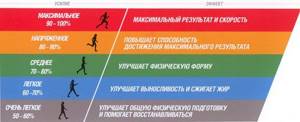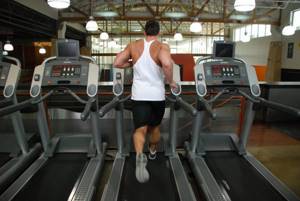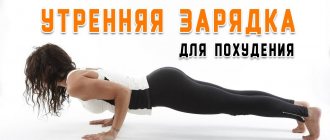What is cardio
The name “cardio”, in fact, comes from the Greek word kardio - heart. Therefore, in theory, cardio training is training the cardiovascular system. However, in fitness rooms, “cardio” began to include any aerobic exercise in general: running, walking on an elliptical, cycling and most group exercises.
Actually, cardio training, namely training the heart and cardiovascular system, is most effective within a certain heart rate range, so you need to constantly monitor it.
You can determine your personal range accurately and individually by passing a test on a gas analyzer (here are our impressions of this procedure).
Or just use the approximate formula: 220 - your age = your maximum heart rate . Cardio training should take place between 60% and 80% of your maximum heart rate. Accordingly, for a 30-year-old person this range is approximately 114-152 beats per minute. If you train below the lower limit, the training will not bring tangible benefits, if higher and without proper preparation, it can do harm.
This is how the “cardio” and “fat burning” zones on the machines are marked, but don’t rush to believe them.
The topic of the pulse zone for fat burning is also very popular (possibly because it is often marked on cardio equipment in gyms): this zone is also determined individually using a gas analyzer test and it is slightly lower: about 60-70% of the maximum heart rate (115-135 beats/ min for the average 30-year-old person).

However, the most important thing about this is that cardio training for fat loss can be effective, like any other activity, but strength training is best (see below: why cardio training is not the best way to lose weight).
Everything you need to know about cardio

Experienced athletes advise including cardio exercises in every workout. What does this give?
- strengthening the heart muscle, which significantly minimizes the risks of heart attack and diabetes;
- getting rid of excess weight;
- increasing the overall tone of the body;
- relieving tension and stress, improving sleep;
Cardio exercise options:
- Running is the easiest and most accessible way for absolutely everyone. However, it is worth remembering that you need to run only in special sneakers with arch support, otherwise you risk getting painful sensations in your knees and shins.
- Cycling or exercise bike. It is very convenient to regulate the speed and load.
- Elliptical trainer.
- Swimming. Many clubs now have swimming pools, so starting your workout with swimming is great!
- Step aerobics. You can practice both at home and in the gym under the guidance of an instructor.
- Walking. This workout can be done anytime and almost anywhere. The only thing to remember is sufficient hand work, which is often forgotten.
- Jump rope.
- Boxing and kickboxing.
Remember that there is no “perfect” cardio workout because cardio includes any physical activity that increases your heart rate. Alternate types of cardio workouts, change equipment so that the workout is not unbearably boring.
How long to do cardio?
For beginners, a few minutes of training will be optimal, which can gradually be increased to 30 minutes. Some sources recommend doing a full hour of cardio exercise. But if you don't have that much free time, give them as many minutes as you can. It's better than not doing cardio. But it’s worth remembering that everything is good in moderation and there’s no need to exhaust yourself with hours of cardio exercises either. This will lead to overtraining, chronic fatigue, and will not have the best effect on your form.
When to do it?
In the morning on an empty stomach.
What's the point? The fact is that in the morning, after fasting all night, the level of hormones in the body is optimal for burning fat, and the blood sugar level in the morning is also low. Therefore, your body will take the energy to perform exercises from fat deposits, and not from the food you eat. The intensity of fasting cardio should be low or medium, the duration should be long. Cardio training should be regular. When performing cardio on an empty stomach, it makes sense to take BCAAs 15-20 minutes before training, this will increase the level of amino acids in the blood and protect your muscles from catabolism (destruction).
After strength training.
Strength training is done with maximum efficiency, at this time glycogen is actively spent, again, subject to proper nutrition. At the end of the cardio workout, there is some remaining strength and a lack of glucose in the blood. The main energy source during cardio exercises should be fat.
Before strength training.
Many people believe that half an hour of work on a cardio machine will deplete glycogen stores, and during strength training the main source of energy will be fat. What is the fact: the energy required for effective strength training is wasted on cardio. The strength part of the training takes place without proper impact and intensity. Protein and only a small part of fat are used as an energy source.
The result: incompletely developed muscles, increased joint wear, significant loss of protein with minimal fat consumption.
Strength and cardio training are separate from each other.
If you have the opportunity to train more than three times a week or twice a day, then it makes sense to separate your cardio and strength training.
What is the “optimal zone”?
During cardio training, you need to monitor your heart rate. Optimal heart rate indicators are calculated using the formula:
Minimum heart rate threshold = (220 - age) x 0.6 Maximum heart rate threshold = (220 - age) x 0.8
It is necessary to calculate these indicators for yourself in advance during cardio exercise, that is, the specific parameters of the “optimal” zone, so as not to violate them if possible. If your heart rate during training is lower than the figure calculated by the formula, then you are not working hard. And if your heart rate is higher, then not only fat is “burned”, but also precious muscles!
How to properly add cardio to your workouts depends on your goals. The most important thing is that it’s not enough to just read and choose, you have to force yourself to overcome your laziness. Have a good workout and success in achieving your goals!
Who needs cardio training and for what purposes?
But first, let’s tell you who and in what cases cardio is recommended :
1. Actually, regular moderate cardio training is recommended for all older people specifically to keep the cardiovascular system in order and, in general, to prolong life.

Cardio helps during the period of fat burning, and interferes with it during weight gain. Choose.
2. If you are building muscle mass, then intense cardio training is not recommended, since its effect on muscle growth is somewhat opposite to hypertrophy. However, during the “cutting” period, having cardio in your training plan (but only together with strength training) will make fat burning even more effective.
3. If you are losing weight, adding cardio to your strength training is also a good idea. Ultimately, everything that increases calorie expenditure benefits weight loss. But remember that cardio is not the most effective way to exercise for weight loss.
4. If you are involved in cyclic sports and you need to develop your endurance, cardio will help you.
5. Cardio for recovery. Light loads have a beneficial effect on the speed of recovery - we wrote extensive material about overtraining and its dangers.
“Cardio” is recommended by many as a warm-up for 5-7 minutes before training, just to warm up the body. However, calling it “cardio” would be wrong; it’s just a warm-up.

The connection between cardio training and diet
A study from the Journal of Obesity looked at obese women who dieted or exercised, or combined diet and exercise, for a year to lose weight. Unsurprisingly, the exercise-diet group lost the most weight, about 20 pounds (and nearly 6% body fat).
However, women who simply dieted weren't far behind, losing about 7 kg (and 4% body fat). And women lost only about 2 kg and a little more than 1% fat with training alone.

All this means is that lifting weights and doing cardio is good, but unless you eat less than you did last month, the only six-pack you'll see will be a 6-pack of Budwiser.
If you cut calories and lift weights three to four days a week (three is the minimum number most trainers say you need to progress), you only need about three cardio days a week to see your abs, recommends Saladino .
Cardio training is not the best way to lose weight
This is generally the most common misconception: women, afraid of “swinging” and hoping to lose weight, storm ellipses in all fitness rooms in the world. However, fears about “swinging” are completely unfounded and we have written more than once that this is completely impossible without steroids and hormones. But using exclusively cardio training for weight loss is a completely workable option, but adding strength training is even more effective.
If you are wondering why the world is so unfair, then read the text “Why do people lose weight not from running, but from weights.”
Yes, it’s true that, say, 45 minutes of cardio can “burn” more calories than during an equal amount of strength training, but the overall effect on weight loss may be worse.
But strength training burns your fats not only during exercise, but mainly during rest, after your workout, significantly raising the overall metabolic rate. In addition, even a small amount of muscle that you may gain due to strength training (for example, 5 kg) requires an additional 50-75 kcal per day to your regular diet just to maintain them, and this does not take into account the work they need to do. I also need more energy. This extra calorie intake makes it a little easier to maintain a small calorie deficit and burn fat on an ongoing basis.
The best effect on fat burning is provided by a combination of full-fledged strength training and cardio training. In order to lose weight, fitness experts recommend 2-3 strength training sessions per week, flavored with 2-3 cardio workouts for 45-60 minutes. Moreover, it is advisable to conduct them on different days, and such a volume of training cannot be afforded right away, but at least with an average level of readiness for stress - that is, if you already regularly go to the gym and have time to recover.
How long to do cardio
Experts advise doing cardio for at least 30 minutes in order for the workout to have at least some effect. But do not forget that if you are completely new to the gym, then you need to start with easy 10-15 minute workouts and gradually increase the load.
Keep in mind that doing cardio for more than an hour can negatively impact muscle growth. Scientists have discovered that although aerobics “burns” fat, after an hour of exercise the body switches to muscle tissue. After 2 hours of cardio training, the body loses up to 90% of leucine, an important amino acid, including one necessary for muscle growth.

Multiple “Mr. Olympia” Jay Cutler does not disdain cardio during the fat burning period.
Here’s what one of the most famous jocks in the world, Jay Cutler, says: “during the preparation for the competition, I decided to push the aerobics and extended the aerobic training to an hour and a half. Immediately I noticed that there was less strength, the muscles “shrank” and lost their usual elasticity. Since then, I have been doing cardio for no longer than 45-50 minutes.”










